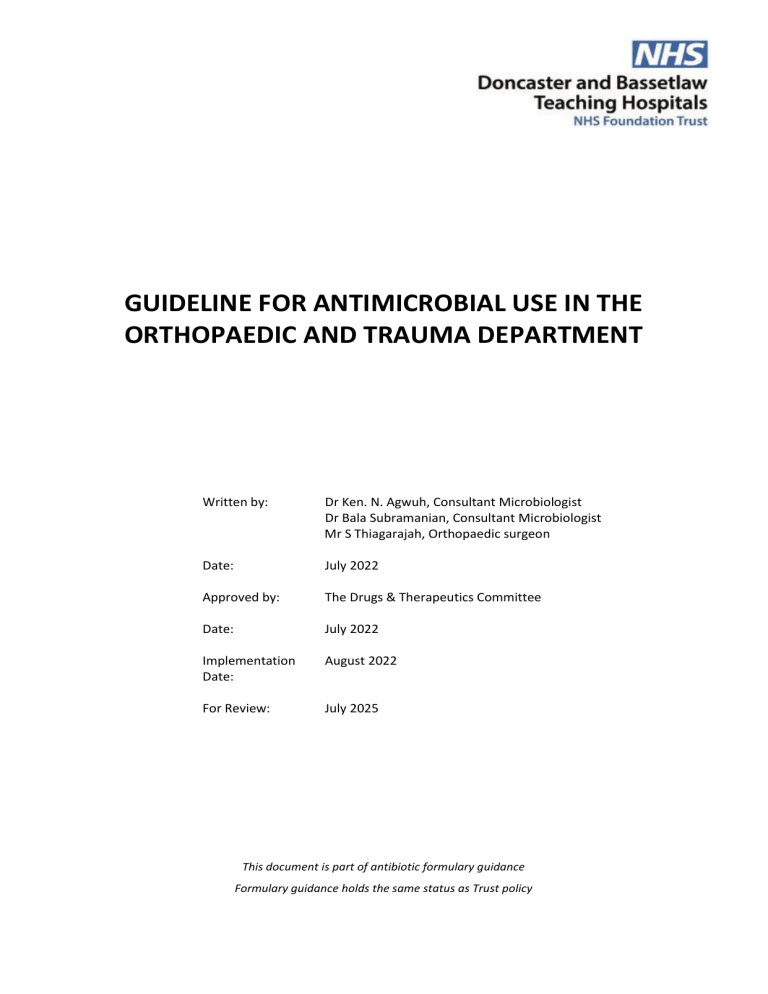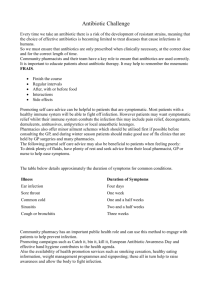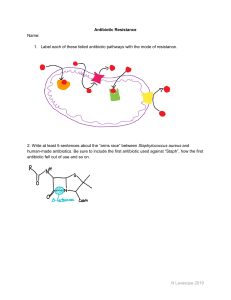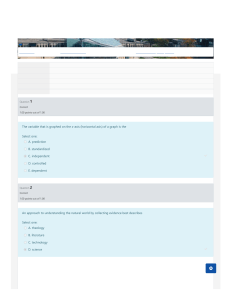GUIDELINE-FOR-ANTIMICROBIAL-USE-IN-THE-ORTHOPAEDIC-AND-TRAUMA-DEPARTMENT
advertisement

GUIDELINE FOR ANTIMICROBIAL USE IN THE ORTHOPAEDIC AND TRAUMA DEPARTMENT Written by: Dr Ken. N. Agwuh, Consultant Microbiologist Dr Bala Subramanian, Consultant Microbiologist Mr S Thiagarajah, Orthopaedic surgeon Date: July 2022 Approved by: The Drugs & Therapeutics Committee Date: July 2022 Implementation Date: August 2022 For Review: July 2025 This document is part of antibiotic formulary guidance Formulary guidance holds the same status as Trust policy AMENDMENT FORM Version Date Brief Summary of Changes Author 5 July 2022 Complete update of guidelines 4 November 2015 Complete review of prophylaxis table and therapeutic section in table format 3 April 2014 Complete update of guidelines Dr B Subramanian Dr K Agwuh Mr Thiagarajah Dr Ken Agwuh Mr Roger Helm, & Mr T Kumar Dr Ken Agwuh Mr Roger Helm, & Mr T Kumar 2 March 2012 Antibiotic prophylaxis added for fractured neck of femur Dr Ken Agwuh, Mr Z Abiddin, & Mr T Kumar 1 May 2011 New policy Dr Ken Agwuh & Mr Z Abiddin BACKGROUND: The aim of this guideline is to provide basic information on prophylactic and therapeutic antimicrobial use in orthopaedic and trauma patients. Prophylactic use of antimicrobials aims at inhibition of growth of contaminating bacteria, mainly skin flora organisms, and their adherence to prosthetic devices or implants, thereby reducing the risk of infection, also to reduce the incidence of surgical site infection. Therapeutic antimicrobial treatment on the other hand, is used to clear infection by an organism. The goals of prophylactic or therapeutic administration of antibiotics to surgical patients should also include antibiotic use in a manner that is supported by evidence of effectiveness, minimise the effect of antibiotics on the patient’s normal bacterial flora, minimise adverse effects and cause minimal change to the patient’s host defences. ORTHOPAEDIC SURGICAL PROPHYLAXIS: SURGICAL PROCEDURE ROUTINE ANTIBIOTIC PENICILLIN ALLERGY RECENT +VE MRSA SCREEN Primary Arthroplasty Teicoplanin IV 600mg single dose + Gentamicin IV 160mg single Revision Arthroplasty‡ dose at induction Discuss with Microbiologist if allergy to either of these agents. (If prolonged surgery > 12 hours, give an additional dose of Open spinal surgery +/instrumentation Teicoplanin) Other orthopaedic implant surgery (any route) Open surgery for closed fracture Open or compound fractures Flucloxacillin IV 2g single dose All Hip Fractures only + Gentamicin 160mg single Teicoplanin IV 600mg single dose + Teicoplanin IV 600mg + Gentamicin 160 mg dose Co-amoxiclav IV 1.2g 8 hourly Cefuroxime IV 1.5g 8 hourly + oral Metronidazole 400mg 8 hourly Prophylactic antibiotic should be given within 30 minutes before the procedure or > 10 minutes before application of tourniquet. *In patients with suspected Periprosthetic Joint Infection (PJI) - antibiotic prophylaxis should be withheld until after cultures from the joint have been obtained. Prophylactic antibiotic should be given up to 30 minutes before the procedure. single dose Gentamicin 160mg single dose SPECIAL INSTRUCTION Discuss with Prophylactic antibiotic should be given up to 30 minutes before the procedure or 10 minutes before application of tourniquet. Microbiologist if Teicoplanin IV 600mg + Gentamicin 160mg single dose at induction. Consider Copal G+C cement in high risk patients (or alternative following discussion with microbiologist) allergy to either of these agents. Start prophylaxis within 3 hours of injury and continue until soft tissue closure or for a maximum of 72 hours, whichever is sooner Prophylactic antibiotic should be given up to 30 minutes before the procedure or 10 minutes before application of tourniquet. ‡ SPECIAL NOTE ON REVISION ARTHROPLASTY At surgeons discretion if operative findings suggestive of infection or if initial Gram stain is positive, antibiotic can be continued until direct culture results on deep samples reported as negative. Antibiotic-loaded cement is recommended in addition to intravenous antibiotic for cemented joint replacements (SIGN guidelines, April 2014). GENTAMICIN DOSING & ADMINISTRATION Dosing advice is based on individuals with normal body weight and renal function If eGFR < 20ml/min, then do NOT use gentamicin (treat with Teicoplanin alone). If patient weighs < 45kg, treat with Gentamicin 80mg single dose. ADULT THERAPEUTIC ANTIMICROBIAL USE: INFECTION ORGANISM Bursitis Staphylococcus aureus Known MRSA Septic arthritis Native joints in non-high risk patients Staphylococcus aureus and Beta haemolytic Streptococci ANTIMICROBIALS PENICILLIN ALLERGY Flucloxacillin IV 1-2g qds Clindamycin IV 600mg -1.2g qds Oral switch: Flucloxacillin 500mg -1g qds Oral switch: Clindamycin 300mg-450mg qds COMMENTS 2-3 week course 80% caused by S. aureus and other Gram positive organisms. Aspirates should be sent for cultures (preferably before first dose of antibiotic) as Gram stain positive in about 2/3rd of cases. Review culture results/sensitivities when available and switch antibiotic if appropriate. Complete drainage is essential. Teicoplanin IV - Follow Trust guideline for dosing Flucloxacillin IV 1-2g qds Oral switch: Flucloxacillin 500mg -1g qds Cefuroxime IV 750mg-1.5g tds Anaphylaxis to Penicillin: Clindamycin IV 600mg -1.2g qds Oral switch: Clindamycin 300mg-450mg qds Known/high risk MRSA MRSA Teicoplanin IV – Follow Trust guideline for dosing Native joint due to penetrating injury Osteomyelitis Acute Usually polymicrobial Co-amoxiclav IV 1.2g tds Flucloxacillin IV 1-2g qds Staphylococcus aureus Others (anaerobes) DURATION Oral switch: Flucloxacillin 500mg -1g qds 4 weeks Urgent debridement and washout, and ensure samples sent for Gram stain/culture and sensitivities. Discuss with microbiologist Clindamycin IV 600mg -1.2g qds Oral switch: Clindamycin 300mg-450mg qds Treat for 4 weeks Most commonly caused by Staphylococci and Streptococci organisms. Send blood cultures and joint aspirate for urgent Gram stain/culture & sensitivities before initiation of antibiotic. Review culture results/sensitivities when available and switch antibiotic if appropriate. 4 – 6 weeks Addition of a 2nd agent may be advised by microbiologist, depending on cultures/sensitivities. Can also be contiguous soft tissue infection (usually poly-microbial) or haematogenous infection (usually mono-bacterial) Blood cultures, orthopaedic tissue/pus samples +/deep wound swabs should be taken before initiation of antibiotic. For High risk patients, Gram Negative organisms may be associated with osteomyelitis. Please seek microbiologist advice. Chronic Please discuss with microbiologist. Duration of treatment longer than in acute osteomyelitis. As above Refer to Trust guideline for skin and soft tissue infection In diabetic patients Post-operative wound infection Removal of urinary catheter post joint replacement Discitis Surgical debridement is the mainstay of management Staphylococcus aureus Others like beta haemolytic Streptococcus Organisms likely to colonise urinary catheter Flucloxacillin IV 1-2g qds Oral switch: Flucloxacillin 500mg -1g qds Clarithromycin IV/PO 500mg bd If MRI shows discitis and the pathogen is not known, hold off antibiotics provided the patient is stable and refer to Spinal MDT Send swab from wound site for cultures There is no benefit in giving antibiotic for removal of urinary catheter post revision surgery (IDSA 2010) No antibiotic indicated. If confirmed pathogen associated with discitis, then treat with appropriate antibiotic based on sensitivities & in accordance with microbiology guidance For 5-7 days review Up to 12 weeks Principles of investigation: Send blood cultures (minimum 2 sets) prior to antibiotics Consider CT-guided disc biopsy if feasible Prolonged antibiotics often required – refer to Spinal MDT for follow up Cellulitis Animal Bites Post-operative chest infection Refer to Trust guideline for skin and soft tissue infection Refer to Trust guidelines for treatment of lower respiratory tract infection PAEDIATRIC ANTIBIOTIC PRESCRIBING: NOTE: Information on paediatric bone/joint infections can be found in the paediatric antibiotic policy. References: American Academy of Orthopaedic Surgeons (AAOS), 2010. Diagnosis of Periprosthetic Joint Infections of the hip and knee. Guideline and evidence report: http://www.aaos.org/research/guidelines/PJIguideline.pdf Berbari EF, Steckelberg JM, Osmon DR, Osteomyelitis. In Mandell, Douglas, and Bennett’s Principles and Practice of Infectious Diseases, Churchill Livingston Elsevier, 7th Ed, 2010, pp 1457-1467. British Orthopaedic Association and British Association of Plastic Reconstructive and Aesthetic Surgeons guideline 2009. Brown EM, Pople IK, de Louvois J, Hedges A, Bayston R, Eisenstein SM, et al.: Spine update: prevention of postoperative infection in patients undergoing spinal surgery. Spine. 2004 Apr 15;29(8):938-45. Hauser CJ, Adams CA Jr, Eachempati SR, Council of the Surgical Infection Society. Surg Infect (Larchmt). 2006 Aug; 7(4):379-405 IDSA: Urinary catheter guidelines (CID) 2010:50(1 March) 625-63. NICE: Joint replacement (primary): hip, knee and shoulder. NICE Guideline [NG157], published June 2020 NICE: Surgical site infection: Prevention and treatment of surgical site infection. NICE Guidelines [NG125], published April 2019, updated Aug 2020 Ohl, CA: Infectious Arthritis of Native Joints. In Mandell, Douglas, and Bennett’s Principles and Practice of Infectious Diseases, Churchill Livingston Elsevier, 7th Ed, 2010, pp 1443-1456. Parvizi J and Gehrke T: Proceedings of the International Consensus Meeting on Periprosthetic Joint Infection: https://www.efort.org/wpcontent/uploads/2013/10/Philadelphia_Consensus.pdf SIGN: Antibiotic Prophylaxis in surgery, Scottish Intercollegiate Guideline Network Publication Number 104, Edinburgh, April 2014.




